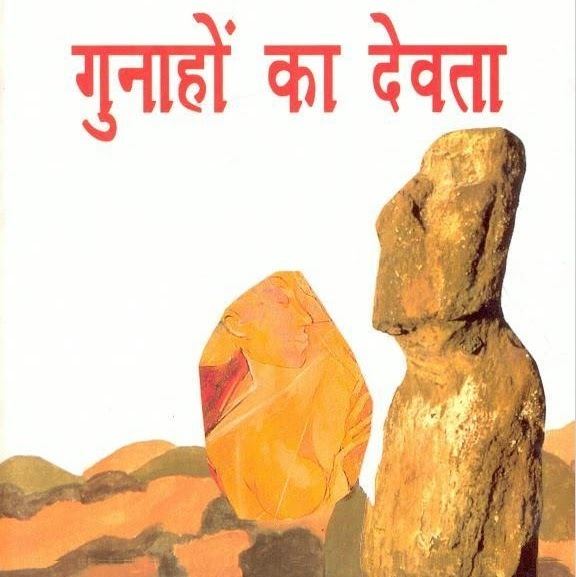8.6 /10 1 Votes8.6
Publication date 1949 Pages 258 Originally published 1949 Publisher Bharatiya Jnanpith | 4.3/5 Goodreads Dewey Decimal 891.433 Genre Fiction | |||||||||||||||||||||||||||||||||
 | ||||||||||||||||||||||||||||||||||
Followed by The Sun's Seventh Horse (1952) Fiction books Nirmala, Essential Man‑Thing - Vol 1, The Unvanquished, Fallen Gods, Alamut | ||||||||||||||||||||||||||||||||||
Gunahon Ka Devta by Dharmveer Bharti (Hindi: गुनाहों का देवता, English: The Deity of the sins) is a popular 1949 Hindi novel by Dharamvir Bharati. Over time, it gained historical importance and a cult following of readers, specially among urban Indian males whose first language is Hindi. The story is about a young student (Chander) who falls in love with the daughter (Sudha) of his college professor. It was published by Bhartiya Jnanpith Trust., and its 55th edition was published in 2009.
Contents
This is Dharamvir Bharati's most famous work, and it earned him a huge fan-following especially in the contemporary youth, as well as several awards and accolades, thus making him one of the most recognised names in Hindi Literature following Munshi Premchand.
Overview
Romance and love which a young heart cherishes are present in this novel with their various shades and colour. It is primarily the story of "non expressive love and romance between two characters (Chandar and Sudha)...", showing various trappings of love in urban middle-class, pre-independence India and mental conflicts of an enthusiastic, ambitious but idealistic youth. The portraying of characters is beautiful, particularly the female protagonist of novel, Sudha touches the heart.
In the novels foreword, the author says, "While writing this novel I experienced the feeling one has during depressing moments when he prays ferevently, with full faith.... It appears as if the very same prayer has been ingrained in my heart and I am still repeating it..."
The novel tells the passionate love story of Chander and Sudha. The plot is simple and devoid of any distracting thrilling moments. Instead it is driven by the interaction of the central characters that is in many ways innocent as well as naive. What makes this novel so unusual, and one of the biggest bestsellers of its time, is the author’s ability to present his characters with conflicting choices that have fatal consequences.
The story is set in Allahabad just after Partition; we are introduced to a young research student, Chandrakumar Kapoor, an orphan, who has a mentor in Dr Shukla, a widower, and who is very close to Dr Shukla’s daughter, Sudha. The two share a relationship that is deep and strong, and their attraction for each other increases with the passage of time. That Sudha is in love with Chander soon becomes clear to the reader and other characters such as Sudha’s best friend, Gesu, and Sudha’s cousin Binti. Chander is from a lower caste than Sudha and that is why he doesn’t dare ask for Sudha’s hand in marriage from her father. While Sudha seems to be fairly 'modern', she cannot stand up to the social pressure to get married to the man of her father’s choice; Chander also forces her to abide by the wishes of her father. This, then, is the turning point in the novel but it is also through this tragedy that Bharati has made the story appealing to readers.
The writer uses this love story to hold a mirror against society’s socioeconomic divide that tears people apart emotionally. Bharati highlights an important point here; while children are taught to follow the values of the society they are born in, and are judged on their ability to make choices according to those standards, it is sometimes psychologically corrosive for people to keep following those ideals. In those moments, resistance against such ideas becomes not only the pragmatic choice for an individual but it is also the only way for societies to move forward.
Chandar has a choice: should he snatch Sudha from the clutches of social taboos or should he let her go and sacrifice his love at the altar of ‘good’ behaviour?
Chandar makes the socially acceptable choice and the consequences of this result in him becoming fully aware of his feelings for Sudha. The agony of an unattainable love burns him up slowly. His calm and rational outlook towards life is replaced by a longing to untie the jumble of his emotions. At this point he turns to Pammi, a Christian girl, to explore the physical aspect of love which was hitherto unknown to him. When even the physical expression of love cannot alleviate his agony he turns to Binti in search of an emotional connection that really isn’t there. With the passage of time, it becomes abundantly clear that his heart longs only for Sudha and no one can replace her in his life.
The writer also suggests that in such a restrictive society, young adults are bound to develop romantic feelings for anyone from the opposite sex whom they get a chance to interact with on a regular basis because they have limited options. While they have been exposed to the modern concept of a loving relationship between two adults, society still considers marriage a sort of bond of compromise rather than a fulfilling relationship.
